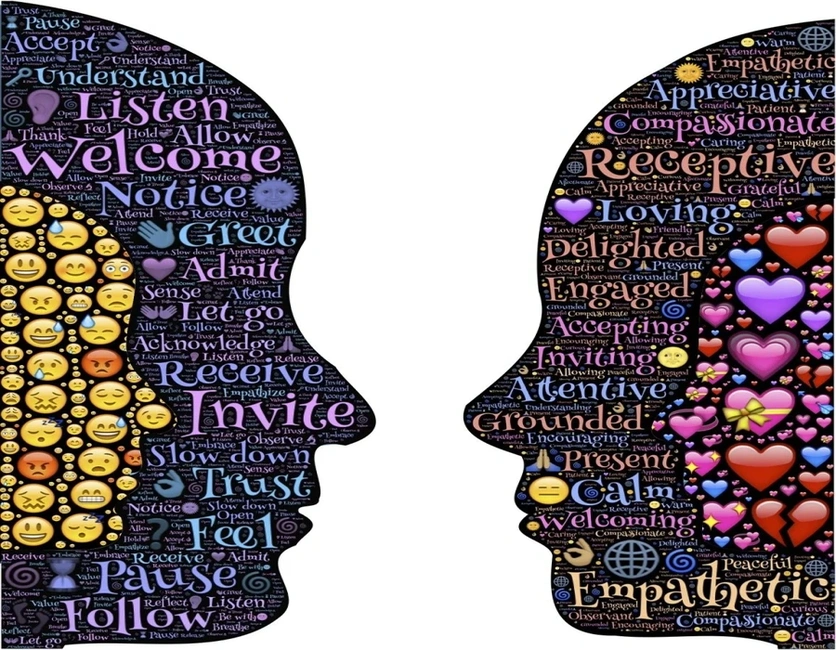The Power of Empathy and Compassion in Caregiving

- Understanding empathy and compassion
- The role of empathy and compassion in building trust and rapport
- The importance of empathy and compassion in caregiving
- The difference between compassion and empathy
- Cultivating empathy and compassion in caregiving
- Signs of a lack of empathy and compassion
- Techniques for practicing empathy and compassion
- Overcoming barriers to empathy and compassion in caregiving
- Resources and Support for empathy and compassion
- Conclusion: The transformative power of empathy and compassion for others in caregiving
- Frequently Asked Questions (FAQs)
Understanding empathy and compassion
This post may contain affiliate links, meaning I may earn a commission if you make a purchase, at no extra cost to you. I only recommend products I trust. Thank you for your support.
Empathy and compassion are two essential qualities in the field of caregiving.
Empathy is the ability to understand and share another person’s feelings. It requires making an active effort to see things from their perspective, without bias or judgment.
Compassion meaning goes beyond feeling empathy towards someone’s pain or distress. It involves taking action and making an effort to alleviate their suffering.
When combined with empathy, compassion can help build stronger connections and foster deeper relationships with others.
When caregivers can empathize and show compassion, they create an environment of safety and support, which is vital for the well-being of the individuals they serve.

The role of empathy and compassion in building trust and rapport
Empathy and compassion serve as the foundation for trust and rapport in caregiving relationships.
When caregivers demonstrate genuine understanding and concern for the emotions and experiences of those in their care, it creates a sense of safety and validation.
This allows individuals to open up, share their concerns, and feel heard. Through empathy, caregivers connect on an emotional level, fostering a deeper understanding of the person’s needs and wants.
Compassion, on the other hand, drives caregivers to take action and provide the necessary support and comfort.
Compassionate and empathetic caregivers make a difference. They connect on a deeper level, provide emotional support, and understand their clients’ unique needs.
By creating a safe and nurturing environment, these qualities can have a positive impact on those they serve.
The importance of empathy and compassion in caregiving
Empathy and compassion are crucial components of effective caregiving.

Here are ten reasons why empathy and compassion are important
- Enhances emotional well-being: By acknowledging and validating the emotions of those in their care, caregivers contribute to their emotional well-being.
- Builds trust: When caregivers are empathetic and compassionate, individuals feel comfortable and safe, leading to the development of trust.
- Improves communication: Empathy and compassion create a safe space for open and honest communication, allowing caregivers to better understand the needs and preferences of those they care for.
- Reduces anxiety and stress: The presence of empathy and compassion helps alleviate anxiety and stress, providing a calming influence on individuals.
- Promotes healing: Empathy and compassion aid in the healing process by providing comfort and support during challenging times.
- Enhances quality of life: When caregivers understand the unique needs and desires of those they care for, they can tailor their approach to enhance the overall quality of life.
- Fosters independence: By empathizing and showing compassion, caregivers empower individuals to maintain their independence while still offering the necessary support.
- Prevents caregiver burnout: When caregivers are empathetic and compassionate, they are more likely to take care of their well-being, reducing the risk of burnout.
- Cultivates a positive environment: Empathy and compassion create a positive atmosphere where individuals feel valued and respected.
- Strengthens relationships: Through empathy and compassion, caregivers build strong relationships with those they care for, leading to long-lasting connections built on trust and support.
The difference between compassion and empathy
While often used interchangeably, empathy and compassion are distinct concepts.
The following table highlights the difference between compassion and empathy:
| Empathy | Compassion |
|---|---|
| Understanding and sharing someone’s feelings | Feeling and expressing concern for someone’s suffering |
| Emotional connection | Desire to alleviate suffering |
| Focuses on the present experience | Extends beyond the immediate situation |
| Feeling with someone | Feeling for someone |
| Identifying with another’s emotions | Motivated to take action |
| Recognizing emotions | Motivated by empathy to provide support |
| Passive response | Active response |
| Understanding from within | Offering comfort from outside |
| Requires emotional intelligence | Involves kindness and caring |
| Fosters connection and understanding | Promotes action and support |
Cultivating empathy and compassion in caregiving
Compassion and empathy can be cultivated and strengthened through conscious effort.

Here are the ten examples of how caregivers can develop these qualities:
- Active listening: Truly listening and seeking to understand the emotions and experiences of those in their care.
- Putting oneself in their shoes: Imagining what it would feel like to be in the other person’s situation.
- Practicing non-judgment: Avoiding judgment and accepting individuals as they are, without imposing personal beliefs or values.
- Validating emotions: Acknowledging and validating the emotions expressed by those in their care.
- Showing empathy through body language: Using open and receptive body language to convey understanding and support.
- Being present: Being fully present and engaged during interactions, giving undivided attention.
- Educating oneself: Learning about different perspectives, cultures, and experiences to broaden understanding and empathy.
- Cultivating self-compassion: Nurturing self-compassion allows caregivers to extend the same kindness and understanding to themselves.
- Practicing random acts of kindness: Engaging in small acts of kindness and compassion towards others on a daily basis.
- Seeking support and reflection: Connecting with other caregivers, seeking supervision, and reflecting on one’s own experiences to continually grow and improve.
Signs of a lack of empathy and compassion
While empathy and compassion are vital in caregiving, a lack of these qualities can have negative consequences.
Here are ten signs that may indicate lack of empathy and compassion:
- Inability to listen attentively or show interest in the emotions of others.
- Disregarding or dismissing the feelings and experiences of those in their care.
- Lack of understanding or empathy towards individual circumstances and challenges.
- Engaging in judgmental or critical behavior towards others.
- Demonstrating a lack of patience or irritability when individuals express their emotions.
- Failing to provide comfort or reassurance during difficult moments.
- Neglecting to consider individual preferences or needs when providing care.
- Displaying a lack of concern for the well-being and happiness of those in their care.
- Inconsistent or unreliable support and assistance.
- Being emotionally detached or indifferent towards the emotions of others.
Techniques for practicing empathy and compassion
Practicing empathy and compassion for others requires intentional effort.
Here are ten techniques that caregivers can employ:
- Reflective listening: Reflect on the emotions and experiences shared by those in their care to show understanding.
- Use open-ended questions: Encourage individuals to express themselves fully by asking questions that invite detailed responses.
- Practice mindfulness: Cultivate awareness of one’s own emotions and reactions to better understand and empathize with others.
- Seek diverse perspectives: Engage with people from different backgrounds and experiences to broaden understanding and empathy.
- Engage in self-care: Taking care of one’s well-being allows caregivers to be more present and compassionate towards others.
- Practice gratitude: Cultivate gratitude for the opportunity to care for others, fostering a positive mindset.
- Engage in acts of kindness: Perform small acts of kindness towards those in their care, showing compassion in daily interactions.
- Practice perspective-taking: Imagine oneself in the shoes of those being cared for to gain a deeper understanding of their experiences.
- Cultivate empathy through reading and storytelling: Engage with literature and stories that depict diverse experiences to develop empathy.
- Attend workshops and training: Participate in workshops and training programs that focus on empathy and compassion to further develop these qualities.
Overcoming barriers to empathy and compassion in caregiving
While empathy and compassion for others are essential in caregiving, various barriers can hinder their expression.
Here are some common barriers and strategies for overcoming them:
- Burnout: Caregivers may become overwhelmed and emotionally drained, reducing their capacity for empathy and compassion. Strategies to overcome burnout include self-care, seeking support, and setting boundaries.
- Emotional detachment: Caregivers may distance themselves emotionally to cope with the challenges of caregiving. Strategies to overcome emotional detachment include reflection, seeking supervision, and cultivating self-compassion.
- Lack of knowledge: Caregivers may lack knowledge about the experiences and needs of those they care for. Strategies to overcome this barrier include continuous learning, seeking information, and engaging with experts in the field.
- Stereotyping and bias: Preconceived notions or biases can hinder the ability to empathize and show compassion. Strategies to overcome bias include self-reflection, challenging assumptions, and seeking diverse perspectives.
- Time constraints: Busy schedules and multiple responsibilities can make it challenging to prioritize empathy and compassion. Strategies to overcome time constraints include effective time management, setting priorities, and incorporating small acts of kindness into daily routines.
Resources and Support for empathy and compassion
Several resources and support systems are available to caregivers seeking to enhance their empathy and compassion:
- T. Denny Sanford Institute for Empathy and Compassion Research: This organization is committed to helping caregivers by providing them with information, research, and resources on how to demonstrate compassion and practice empathy.
- The Center for Compassion and Altruism Research and Education (CCARE): A research institute at Stanford University focused on cultivating compassion and promoting well-being.
- Caregiver Action Network: A nonprofit organization providing resources, support, and advocacy for caregivers.
- The Compassionate Mind Foundation: An organization dedicated to promoting compassion in various contexts, including caregiving.
- The National Alliance for Caregiving: A coalition of organizations providing support and resources to caregivers.
Conclusion: The transformative power of empathy and compassion for others in caregiving
Empathy and compassion are transformative qualities in the realm of caregiving.
By understanding and sharing the emotions of those in their care, caregivers can build trust, enhance communication, and improve the overall well-being of individuals.
Through empathy, caregivers connect on an emotional level, while compassion drives them to provide the necessary support and comfort.
These qualities have numerous positive impacts, including improved emotional well-being, reduced stress, and strengthened relationships.
By cultivating empathy and compassion, caregivers create a positive and nurturing environment that enhances the quality of care and empowers individuals to maintain their independence.
As a caregiver, I strongly suggest you explore these articles:
- Tips and resources on cancer caregiving
- Hip fracture recovery tips for caregivers
- 7-day meal plan for kidney disease
- Cognitive stimulation therapy for mental agility
- Finding respite care services in your area
- Powerful tools for caregivers
- Assistive devices for the elderly
- Find speech therapy in your area
Frequently Asked Questions (FAQs)
What is the difference between empathy and compassion?
Empathy refers to the ability to understand and share the feelings of another person, while compassion involves the desire to alleviate their suffering. Empathy focuses on emotional connection and understanding, while compassion is motivated to take action and provide support.
How can caregivers cultivate empathy and compassion?
Caregivers can cultivate empathy and compassion by actively listening, practicing perspective-taking, engaging in acts of kindness, seeking diverse perspectives, and practicing self-care, among other techniques.
What are the signs of a lack of empathy and compassion in caregiving?
Signs of a lack of empathy and compassion include an inability to listen attentively, dismissing the emotions of others, demonstrating judgmental behavior, and neglecting individual needs and preferences.
How do empathy and compassion impact caregiving?
Empathy and compassion enhance emotional well-being, build trust, improve communication, reduce stress and anxiety, and strengthen relationships in caregiving relationships. They also contribute to better health outcomes, increased satisfaction, and a positive atmosphere.
What resources are available to caregivers seeking to enhance their empathy and compassion?
Resources such as Compassion International, Empathy and Compassion Research, the Center for Compassion and Altruism Research and Education (CCARE), the Caregiver Action Network, the Compassionate Mind Foundation, and the National Alliance for Caregiving offer support, information, and resources for caregivers.
Can compassion be learned, or is it an innate quality?
While some may have a natural inclination, compassion can indeed be cultivated through conscious efforts and practice.




